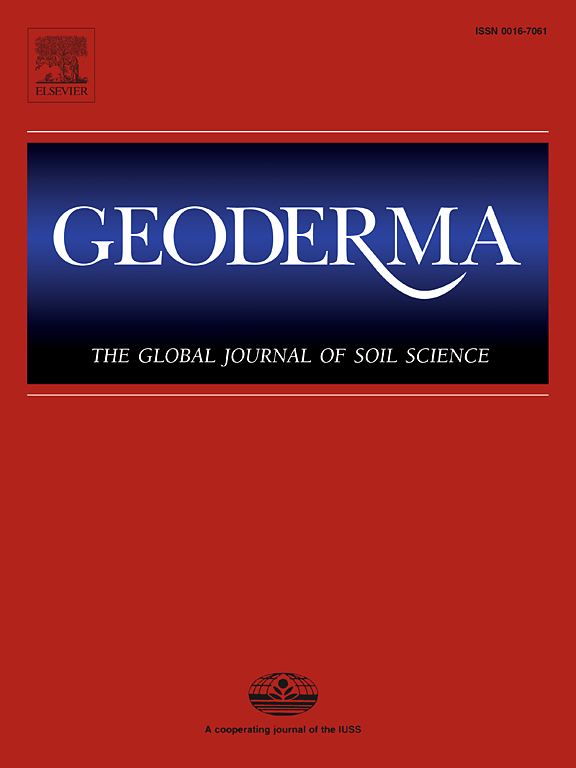Dynamic response of soil water to rainfall for different runoff plots on a karst hillslope
IF 5.6
1区 农林科学
Q1 SOIL SCIENCE
引用次数: 0
Abstract
Differences in land use on karst hillslopes inevitably lead to variations in the response of soil water to rainfall, resulting in differences in hydrology and erosion processes. Nevertheless, long-term and high-integrity in situ field monitoring data from runoff plots on karst slopes remain limited, therefore, the dynamic changes of soil water in response to rainfall under natural precipitation conditions are still unclear. This study was conducted to quantify the spatiotemporal dynamic changes in soil water for three different runoff plots (grassland, farmland, and bare land) on a karst hillslope. Soil water was measured across 0–100 cm profiles at 15 min intervals from June to December 2022. The results demonstrate that the average soil water content in the vertical profile was in the order of grassland > farmland > bare land. There was a soil water deficient layer in the vertical profile, such as grassland at 20 cm and 60 cm, farmland at 40 cm, and bare land at 20 cm. Light rainfall of 5.4 mm affected only the 0–20 cm surface layer of grassland, moderate rainfall of 20.8 mm influenced the 0–40 cm shallow soil water content. Notably, rainfall events exceeding 40.8 mm induced soil water dynamic responses throughout the entire 0–100 cm soil profile, and this phenomenon has important regional significance. In runoff plots, the temporal and spatial variations of soil water content across soil profiles are significantly affected by rainfall characteristics and land uses. For the entire soil profile, there was a significant correlation among the rainfall amount, rainfall duration, and increase in the soil water content. Moreover, the correlation coefficient between rainfall and the soil water content decreased with increasing soil depth. In both the less rainy period and the rainy period, the efficiency of soil water storage in each layer decreased in the following order: grassland > farmland > bare land. The differences in soil water storage for different karst runoff plots were controlled mainly by the amount of rainfall. It is suggested that grassland should be given priority for hillslope land use in humid karst areas, followed by farmland. The results contribute to a better understanding of the spatiotemporal distribution characteristics and influencing factors of soil water on karst hillslopes, providing theoretical references for the management of soil water resources, soil and water conservation, and the formulation of ecological restoration policies for rocky karst desertification areas.
喀斯特坡面不同径流样地土壤水分对降雨的动态响应
喀斯特坡地土地利用方式的不同,必然导致土壤水分对降雨的响应不同,从而导致水文和侵蚀过程的差异。然而,由于喀斯特坡面径流样地长期、高完整性的现场监测数据有限,自然降水条件下土壤水分对降雨响应的动态变化尚不清楚。研究了喀斯特坡地3个不同径流样地(草地、农田和裸地)土壤水分的时空动态变化。从2022年6月到12月,每隔15分钟测量0-100厘米剖面的土壤水分。结果表明:垂直剖面土壤平均含水量依次为:草地;农田祝辞裸露的土地。垂直剖面上存在20 cm和60 cm的草地、40 cm的农田、20 cm的裸地等土壤亏水层。5.4 mm小雨仅影响0 ~ 20 cm表层土壤含水量,20.8 mm中雨影响0 ~ 40 cm浅层土壤含水量。值得注意的是,超过40.8 mm的降雨事件在整个0-100 cm土壤剖面上引起了土壤水动力响应,这一现象具有重要的区域意义。径流样地土壤含水量时空变化受降雨特征和土地利用方式的显著影响。在整个土壤剖面上,降雨量、降雨持续时间与土壤含水量的增加呈显著相关。降雨与土壤含水量的相关系数随土层深度的增加而减小。在少雨期和多雨期,各层土壤蓄水效率下降的顺序为:草地;农田祝辞裸露的土地。不同岩溶径流区土壤储水量的差异主要受降雨量控制。建议湿润喀斯特地区坡地优先利用草地,其次是农田。研究结果有助于更好地了解喀斯特坡地土壤水分的时空分布特征及其影响因素,为石漠化地区土壤水资源管理、水土保持及生态修复政策的制定提供理论参考。
本文章由计算机程序翻译,如有差异,请以英文原文为准。
求助全文
约1分钟内获得全文
求助全文
来源期刊

Geoderma
农林科学-土壤科学
CiteScore
11.80
自引率
6.60%
发文量
597
审稿时长
58 days
期刊介绍:
Geoderma - the global journal of soil science - welcomes authors, readers and soil research from all parts of the world, encourages worldwide soil studies, and embraces all aspects of soil science and its associated pedagogy. The journal particularly welcomes interdisciplinary work focusing on dynamic soil processes and functions across space and time.
 求助内容:
求助内容: 应助结果提醒方式:
应助结果提醒方式:


